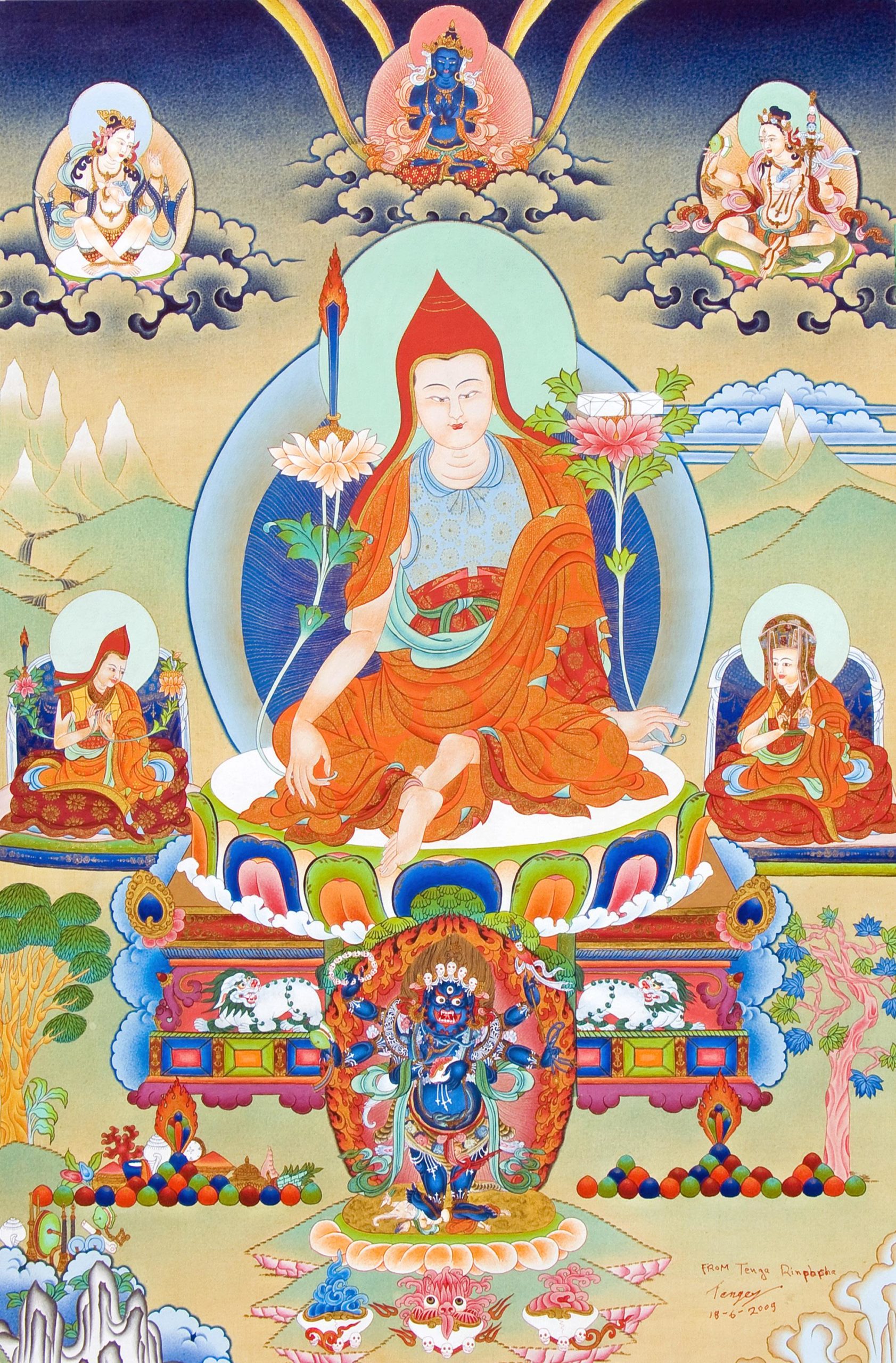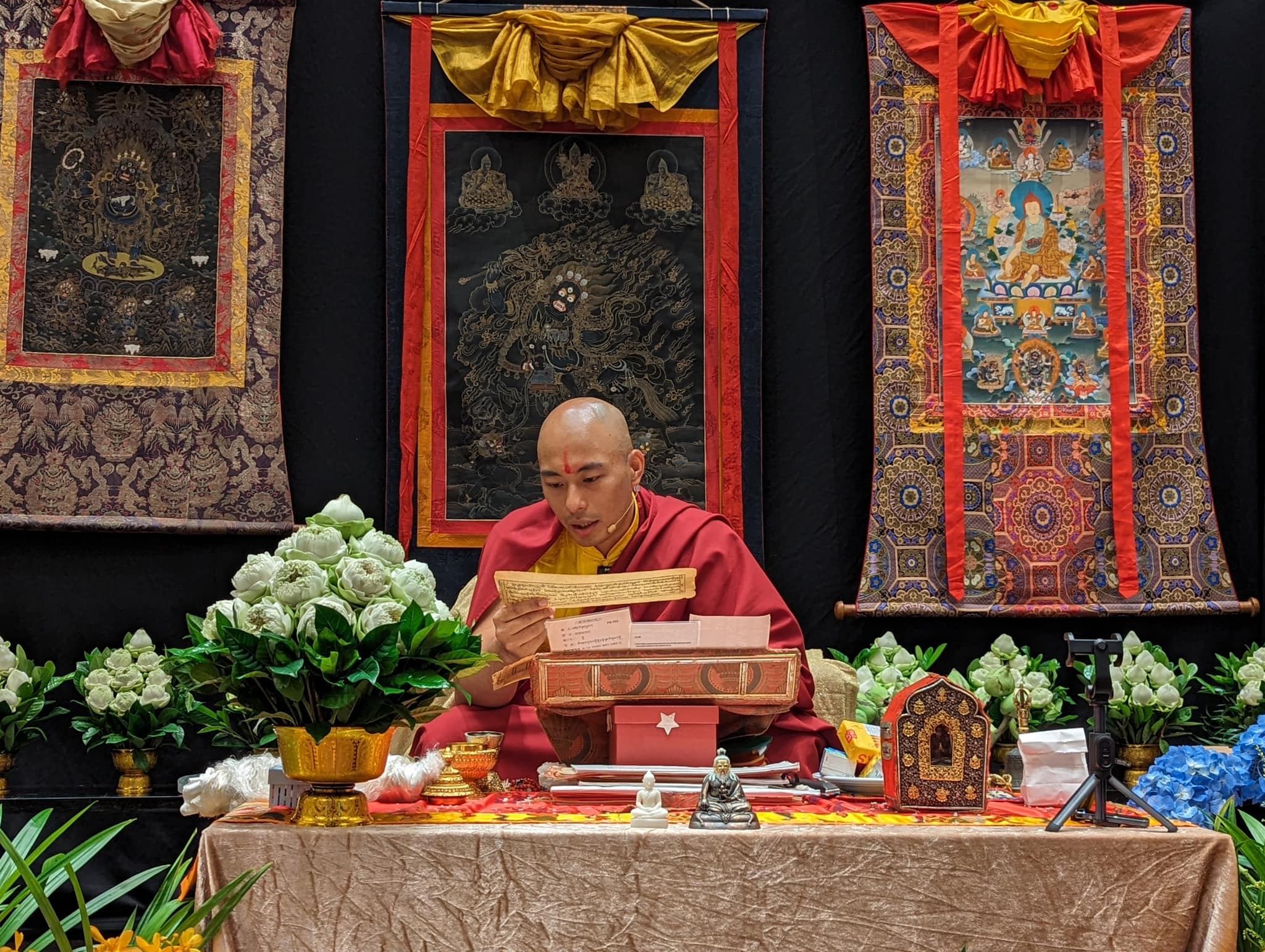
The other teachings in a Shangpa lineage, I think this is just a background history, just to know a little bit. The most important figure in Shangpa lineage: Number One is Niguma and Sukhasiddhi and Shawaripa.
Because Niguma and Sukhasiddhi they have their own teachings, like a Six Yogas of Sukhasiddhi, and then the Six Yogas of Niguma, and the Five Golden Dharma of Niguma as you aware of it last night. And then the third one is Shawaripa, without the Shawaripa, there wouldn’t Six-Armed Mahakala practice and the origin and so on.
And without the fourth master that is very important is a Dorjé Denpa, he’s the Abbot of the, he was the Abbot of the Bodhgaya stupa. Without him, there wouldn’t be a Five Tantric Deities and lineage and practice. So these are the few masters that are very important in terms of the origin.
So Shawaripa, Dorjé Denpa, and then Niguma, Sukhasiddhi. So these are the origin. Of course after that, there’s a many different figures, you know? Like the person who gives all the transmission and teachings to Shangpa masters and so on.
And then the, the second categories of important master is Khyungpo master himself. Without him, there wouldn’t be a teachings or practice. He’s the one that unite all the four different lineage, origins of teaching and he’s the one that who, succeeds in bringing, and not just bringing teachings, but also translating as well. So he’s known as a, The Great Translator, as well as a great master. So that’s that. And then followed by, of course there’s a seven, you know, the rest of the five different masters, and four masters and so on, after him.
And then after that, the most important figure who revived the, the teachings and lineage, and method of practice and instructions is Taranatha. So the Taranatha is a, I would say the one who revived the lineage, because without Taranatha, there will be nothing left for us to read. Let’s say Taranatha is little bit like a, a Wikipedia, you know? Who gathered all the different information, teachings and practice, and not making a distinction “oh I like this master” or “don’t like that master” not having any sort of opinion but rather bringing all the teachings, and also bringing into a practicality for, for, for the student to practice as well. And not just teachings, but also how to give the empowerment, how to do the practice, how to set up the shrine, and then how do you start the prayers and practice, how do you end the practice, when you do the retreat of the Six-Armed Mahakala, how many times you read this one, how many times, how, how can I describe, to go up and down in terms of the text, you know? So all that manuscript is based on Taranatha.
Without Taranatha’s work, Jamgön Kongtrül Lodrö Thayé have nothing to work on it. Jamgön Kongtrül Lodrö Thayé’s inspiration, blueprint, is partially by, from the, from the Naro Cho Druk practice and then also blueprint from Taranatha. So the combination of the both is the work of Jamgön Kongtrül Lodrö Thayé, of his influence in the Shangpa lineage in terms of the practice, do you understand? yeah?
So it’s not like everybody is inventor, you know? So they have the different skills, and each of the master contributed their own way, in whatever, you know, whether it’s a practice, whether it’s empowerment, whether it’s a transmission, whether it’s a instruction on how to do the practice, how to do the visualisation, and also explaining “oh this master’s origin has this method of explanation, this way of visualising, this way of practicing” and equally explaining “this master, that master, and that version of way of explanation” and teachings and so on.
So, so I think these are the things that we have to understand.

And then again, regardless of all these masters, without previous Kalu Rinpoche, bringing all the Shangpa volume together, you know, again, if he … this, so previous Kalu Rinpoche was the one that, who brought all the different practice, whether it’s from Jonang lineage, whether it’s from Gelugpa lineage, whether it’s from a Thangtong Gyalpo’s lineage, whether it’s a, from the Kagyupa lineage, you know, so he combined all together. Then he made it into a volume, so that every practice and, can be understood, and studied and learned, and transmitted and so on.
So that’s that. Just so you know. Because everyone in the, some, some of them in between, they just maintain their, you know, the lineage, and they just have don’t have that much of a historical impact. I mean of course, spiritually you have great realised being, but in terms of, not so much of reviving, nothing much, but just more or less just maintaining the, the lineage, and then it goes on for the third one, the fifth one, the sixth one, just a great master, great practitioner, great realisation being, but nothing so much in between. So that’s that. Yeah.
And then my relation with the Niguma’s teachings and practice, you know, I received a, the full Shangpa transmission from, from Gyaltsab Rinpoche, in early 2000, and then from Bokar Rinpoche, and then also from Situ Rinpoche, and little bit of empowerment from Six-Armed Mahakala, special Six-Armed Mahakala empowerment from Kyabje Tenga Rinpoche, so, so that’s that. I received the Nyingshuk practice from Tenga Rinpoche. Nyingshuk practice is a, you know, the Six-Armed Mahakala bringing, bringing Six-Armed Mahakala to your heart. So that is not for everybody, but other than that, everything is for everybody, you know? That is for the person who is lineage, holding the lineage, or has permission to give the empowerment to the one to the next, and that sort of thing. So that’s that.
And yep, so now you know the whole brief history about it.
Then it was, you know, after I finished the Three Years Retreat, it was Situ Rinpoche that I consulted with, saying that “I want to uphold the Shangpa lineage”.
Niguma Yoga retreat
Bangkok Tuesday 3rd October 10am
Comments are closed.